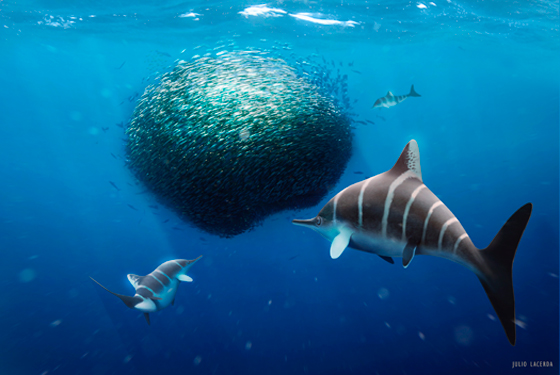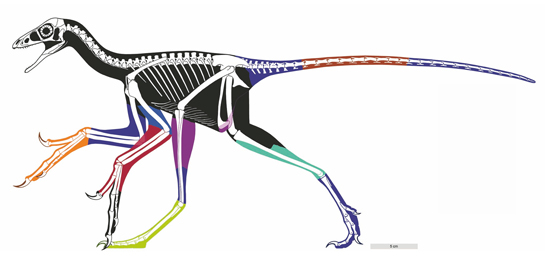Scientists have analysed the soft tissue preserved in a nearly complete Jurassic plesiosaur fossil. This is the first in-depth study of plesiosaur soft tissues to be published. The study has been published in the journal “Current Biology”. The research was led by scientists from Lund University (Sweden). The results show that some plesiosaurs had smooth skin on the body and small scales on the flippers. This integumentary covering permitted maximum swimming efficiency by reducing drag. The scales on the flippers are reminiscent of modern reptile scales. They may have played a role in flipper hydrodynamics and/or provided protection and traction as these marine reptiles moved across rough seabeds in search of food (benthic feeding).

Reconstruction of the new plesiosaur with scales on the flipper and smooth scale-less skin along the body as informed by this new plesiosaur fossil. This is a significant update to how we reconstruct plesiosaurs which has otherwise not changed substantially since their initial discovery more than 200 years ago. Picture credit: Joschua Knüppe.
Picture credit: Joschua Knüppe
Studying a Remarkable Jurassic Plesiosaur
Plesiosaurs are an iconic group of Mesozoic marine reptiles with an evolutionary history spanning over 140 million years Their skeletal remains have been discovered worldwide. However, accompanying fossilised soft tissues are exceptionally rare. Only eight instances of plesiosaur soft tissue preservation have been reported to date. The research team examined a beautifully preserved fossil specimen from the Lower Jurassic Posidonia Shale (Posidonienschiefer Formation) of southern Germany. The fossil is estimated to be around 183 million years old. It dates from the Toarcian faunal stage of the Early Jurassic.

Skeleton of the new plesiosaur at the Urwelt-Museum Hauff in Holzmaden, Germany. Picture credit: Klaus Nilkens/Urwelt-Museum Hauff.
Picture credit: Klaus Nilkens/Urwelt-Museum Hauff
Until now, little was known about the external anatomy of plesiosaurs. For example, considerable debate has occurred in regards to whether plesiosaurs had tail flukes, and if they did, what shape they were. In 2021, CollectA introduced a replica of the Late Cretaceous derived plesiosaur Elasmosaurus. This model had a diamond-shaped tail fluke. In Everything Dinosaur’s video review of this figure, the controversy over the tail fluke was highlighted.
To read more about this and to view Everything Dinosaur’s video review: New for 2021 CollectA Figures Including a New Interpretation of Elasmosaurus.
The specimen (MH 7) was excavated from a quarry near the town of Holzmaden in 1940. More complete preparation undertaken in 2020 revealed traces of soft tissue preservation. The soft tissue was associated with the tail and the trailing edge of the right forelimb.

Skin from the bottom half of the tail in the new plesiosaur. The skin as preserved is beige in colour with some parts showing a pitted surface. This pitted surface represents the underside of the skin, with the outer surface facing into the rock matrix. Picture credit: Klaus Nilkens/Urwelt-Museum Hauff.
Picture credit: Klaus Nilkens/Urwelt-Museum Hauff
What Does Specimen MH 7 Reveal?
The scientists utilised a variety of techniques, including transmitted light microscopy (TLM), scanning electron microscopy (SEM) and energy-dispersive X-ray spectroscopy (EDX), examining specimen MH 7 in unprecedented detail. In addition, the researchers used electron backscatter diffraction (EBSD), infrared (IR) microspectroscopy, and time-of-flight secondary ion mass spectrometry (ToF-SIMS) to reveal details of the integumentary covering including the identification of potential melanosomes.
Their research indicates that plesiosaurs had both smooth and scaly skin.

The tip of the right flipper with two scales along the trailing edge. Picture credit: Klaus Nilkens/Urwelt-Museum Hauff.
Picture credit: Klaus Nilkens/Urwelt-Museum Hauff
Lead author of the study into this remarkable Jurassic plesiosaur fossil, Miguel Marx, a PhD student in geology at Lund University commented:
“Fossilised soft tissue, such as skin and internal organs, is exceptionally rare. We used a broad range of techniques to identify smooth skin in the tail region as well as scales along the rear edge of the flippers. This provided us with unparalleled insights into the appearance and biology of these long-extinct reptiles.”
Smooth and Scaly Skin
An unusual combination of smooth and scaly skin on different parts of the body was revealed. The scientists conclude that this variation related to different functions. For example, the plesiosaur needed to be streamlined so that it could swim efficiently. Moreover, the smooth and hydrodynamic skin would have reduced drag and helped the animal to use less energy as it swam after prey. However, it also needed to move across rough seafloors, the scaly flippers would have likely allowed it to do so with maximum efficiency and without damaging its skin.
Miguel Marx added:
“Our findings help us create more accurate life reconstructions of plesiosaurs, something that has been extremely difficult since they were first studied over 200 years ago. Also, the well-preserved German fossil really highlights the potential for soft tissue in providing valuable insights into the biology of these long-extinct animals.”

A close-up image of the two scales from the right flipper. Note the triangular shape of the scale remnants that are distinct from the skin found on the tail of this plesiosaur.
Picture credit: Klaus Nilkens/Urwelt-Museum Hauff.
Picture credit: Klaus Nilkens/Urwelt-Museum Hauff
Reconstructing the Appearance of an Ancient Marine Reptile
With a better understanding of the anatomy and adaptations of extinct creatures palaeontologists can develop an improved understanding of macroevolution. Furthermore, in recreating the past, scientists can make better predictions about future events.
Summarising the importance of this study, Miguel Marx stated:
“Apart from the mosaic of smooth skin and scales, it was an incredible moment to visualize the cells in thin sections of the fossilized plesiosaur’s skin. I was shocked when I saw skin cells that had been preserved for 183 million years. It was almost like looking at modern skin.”
In addition to Lund University, collaborators from Uppsala University, RISE (Research Institutes of Sweden), Naturkunde-Museum Bielefeld, and Urwelt-Museum Hauff took part in this research.
Everything Dinosaur acknowledges the assistance of a media release from Lund University in the compilation of this article.
The scientific paper: “Skin, scales, and cells in a Jurassic plesiosaur” by Miguel Marx, Peter Sjövall, Benjamin P. Kear, Martin Jarenmark, Mats E. Eriksson, Sven Sachs, Klaus Nilkens, Michiel Op De Beeck and Johan Lindgren published in Current Biology.
The award-winning Everything Dinosaur website: Models of Prehistoric Animals.




Leave A Comment